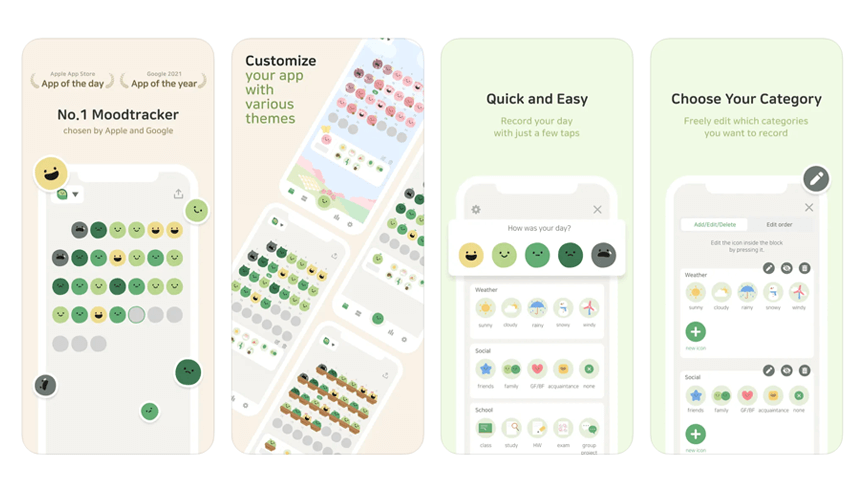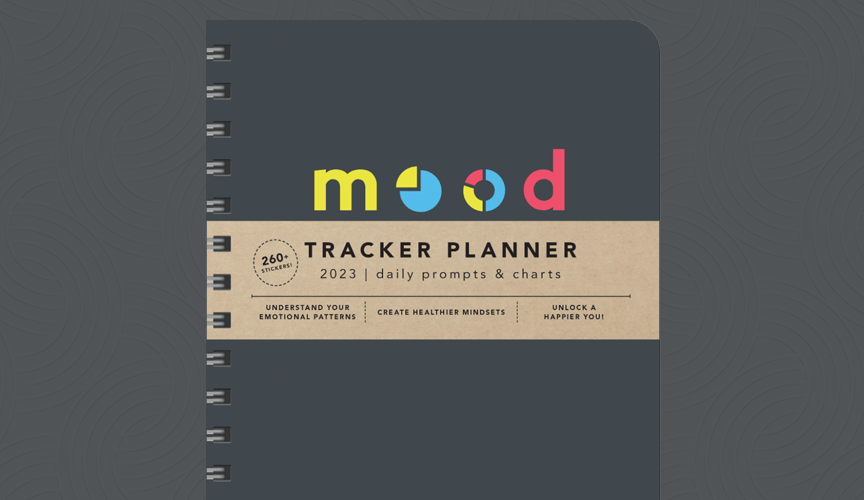We all have our days.
You’re feeling anxious, irritable, or just low energy. Everything feels off.
It can be even more frustrating when you don’t know what’s causing this mood, or how to get back to your “normal” state.
Today, we’ll talk about moods. How to identify, manage and control them.
How tracking your mood is going to be a great help, and how all this is going to improve your overall well-being.
Can we take a step back to start from the beginning?
Let’s define what a “Mood” is
A mood is a prolonged emotional state that can last for hours, days, or even weeks. They are an integral part of your daily life.
Moods can be difficult to manage and they can affect our behavior, thoughts, and emotions.
So, moods and emotions are not the same things?
The difference between moods and emotions
Well, we use the term interchangeably to describe them but no, they’re not the same thing. Actually, understanding how they’re different can help you manage your feelings better.
We said that moods can last for longer periods of time, emotions on the other hand can have a shorter lifespan because they are usually triggered by an event.
We also know that emotions can be more intense and can cause a series of physical and mental responses like changes in heart rate, breathing, and muscle tension, while moods are a lot more subtle.
Emotions can be easily addressed if you identify the trigger and create a positive experience in the moment. For example, if you’re feeling emotional because of something you saw on your way to work this morning, you may be able to overcome the emotion by having a conversation with a friend or doing a quick meditation.
Moods are more long-term, you’ll need other techniques like changing some habits, a little bit of self-care, or even seeking professional help.
What causes Moods
If an emotion is caused by an event or experience, what causes a mood?
Moods are triggered by a few different factors:
Biological
Yup, your biology.
For example, hormones create mood swings during menstruation, and serotonin and dopamine imbalances trigger mood disorders like depression or anxiety.
Some people are more vulnerable to mood changes depending on genetics.
Environmental
Your environment plays a huge role.
An easy example is your workstation. Is there enough light? Is it too noisy? Too messy? Is your husband running the A/C like he’s trying to match the weather in Oymyakon, Siberia? (that’s just me, I guess). 🥶
External elements can definitely affect our moods.
I’ll share with you my #1 “environmental mood adjuster:” Music.
Psychological
Thoughts, beliefs… Everything from negative self-talk to perfectionism and unrealistic expectations can contribute to sadness, anger, anxiety, etc.
Obviously, your psychology can be a major player, especially if things like trauma, grief, or stress are left unattended.
Lifestyle
Let’s also include your lifestyle. I like this one because it feels like you have more power over things like diet, sleep, physical activity, etc.
You’ll agree that your mood is clearly different after eating a pint of ice cream late at night on the couch and after a one-hour hike overlooking the pacific ocean.
What it means to “Track your Mood”
Oh, the art of tracking your mood.
![]()
Alright, so we have covered what moods are, how they’re different from emotions, and what causes them. Now let’s talk about what it means to “track your mood” and its benefits, how to do it, the best practices, and the tools.
Tracking your mood simply means monitoring and recording your moods over time in order to be able to identify them, and understand what affects them and how to manage them.
Record your emotional state over a period of time at regular times of the day using a tracking method like a journal or an app, it can be a scale or a color-coded system.
Sure, while the gamification aspect of tracking your mood sounds very entertaining, this is a very powerful tool that can provide a better understanding of who you are through your moods over time and should definitely be part of your self-care toolbox.
The benefits of tracking your mood
Tracking your mood has many benefits for your mental health, like…
- Improved self-awareness: Develop a better understanding of your own emotional state
- Better mental health management: Identify when symptoms of depression or anxiety are getting worse and take action before it gets overwhelming
- Increased productivity: Identify when you’re most productive and schedule your day to match your moods
But the most important benefit of tracking your mood is…
Understanding your patterns and triggers
If you track your mood over time, you’ll begin to notice patterns. This can be incredibly important to get to know your emotional state.
Do you think it would be helpful to understand, for example, that Mondays are not particularly exciting for you? Or that, sorry but you’re not a morning person? Or that you are able to focus more on your writing in the evenings?
Imagine how making some minor adjustments to your daily routine could have a significant impact on the outcome.
Just based on the example above, you could schedule all the admin tasks and emails in the morning and create a time block without interruptions in the afternoon to focus on more creative work.
But also, having full visibility of these patterns could help take better care of your mental health.
The easiest example of this is my husband, he knows when the decrease in energy is coming, so he works out immediately. You can hear the music in his office change to a very loud Argentinian Ska or Reggae.
Also, Monday mornings are a slow start, writing can turn into a state of flow and make him lose touch with the world for a good minute, you get the picture…
You can say I’m pretty familiar with this guy’s happy place. 😁
How to track your mood [the right way]

Tracking your mood shouldn’t take more than a few minutes, and you should make sure to keep it simple, but there are a few essential practices to make sure you do it in an effective and sustainable manner.
Let’s take a look…
The Methods to Track Your Mood
It’s very important to pick the method that works for you. There are many ways to track your mood, from sophisticated apps to pen-and-paper.
Here are some of the methods to track your mood:
- Journaling: Writing down your mood and details in a journal
- Bullet journaling: Using a bullet journal to track your mood along with other aspects of your life, such as sleep, exercise, and nutrition
- Apps: Mood tracking apps may include features like automatic tracking, data visualization, and mood prediction
Most importantly, make sure this is a method you will be able to access at any moment and it is simple enough to operate quickly.
Track your mood consistently
In order to get an accurate picture of your moods, patterns, and changes over time, you need to be consistent.
You are now basically collecting data on yourself.
For this data to be useful, establish regular times during the day and/or week and do it for an extended period of time.
If it’s hard to keep up at the beginning, try making it part of your daily routine or add alerts to your calendar.
Keep Notes
We’ve established that one of the goals of mood tracking is to be able to identify patterns and triggers. To make it even better, try taking notes on what may have caused a particular mood or change in your emotional state.
For example, you may notice that your anxiety is a little higher after a night of poor sleep or your mood is better after spending time with friends.
Observe, make a note, and learn.
Analyze Patterns
Okay, it’s time to start analyzing your data and making the necessary adjustments.
Look for patterns and trends over time, and try to identify any factors consistently affecting your mood in a positive or negative way.
These patterns and trends will allow you to make adjustments in your life like sleeping habits, a better diet, or increasing social interactions.
You can say that mood tracking is a self-awareness and self-improvement tool.
Best apps to track your mood
We like apps because they’re a very convenient and portable way to record your moods and track your mental health over time.
There are several apps to track your mood, let’s look at the most popular ones…
How We Feel
![]()
How We Feel is an app created by the How We Feel Project, a non-profit organization led by Ben Silbermann, co-founder of Pinterest, and Dr. Marc Brackett, author of Permission to Feel and head of the Center of Emotional Intelligence team at Yale.
Yes, the app is completely free and has no premium version.
I particularly love the simplicity, of tracking your mood, spotting patterns, and learning how to help yourself with great content.
It seems to be available for iOS only at the moment.
Daylio

Daylio is a Self-Care Bullet Journal with Goals Mood Diary & Happiness Tracker. It was named “App of the Day” by Apple and “Editor’s Pick” by Google.
This app allows you to track your mood and activities in just a few taps. The app features a customizable mood tracker, daily reminder notifications, and a calendar view to help you spot patterns and trends. You can also track activities and habits that may be impacting your moods, such as exercise and sleep.
It is available for both iOS and Android.
MoodKit
Developed by ThrivePort, MoodKit is also very popular, was voted “Best Overall Mental Health App” by VeryWell Mind in 2020,2021, and 2022, and has a 4.3 rating to back it up.
It is based on CBT (Cognitive Behavioral Therapy) techniques and, besides the Mood Tracker, it also includes features like activities, a journal, and the “Thought Checker” that allows you to manage negative feelings.
The app is also available for iOS and Android. And it is $4.99 to download.
eMoods
eMoods is an app to track moods and data related to Bipolar I and II disorders, depression, and anxiety.
It was named “Best App 2020” by Healthline.
You can identify triggers and patterns to prevent relapses. You can print out tracking reports or create PDF versions of them. It includes very visual charts and insights so you see patterns for different symptoms and how they relate to other symptoms.
eMoods offers different plans starting with a free version that includes all tracking features, and paid plans of $50 and $100/per year.
It is available for iOS, Android and has a web-based version.
DailyBean – simplest journal

DailyBean is one of the younger apps but it was already named “App of the day” by Apple and “App of the Year” by Google in 2021.
It feels very simple and the UI is very minimalistic, but it is packed with features like the Timeline, Mood Statistics, Activity Analysis, and backups for your data.
It is free to download with in-app purchases.
And you can get it for iPhone and Android.
Other methods to track your mood
Don’t want to do this on an app? No problem, here are a few options for you:
Mood Tracker Planner

The Mood Tracker Planner is pretty much a 12-month weekly planner with a focus on wellness.
It guides you to reflect on emotions, gain insights on your moods, triggers, and coping skills, work through prompts to boost your self-esteem, and set meaningful goals and habits.
The price at the moment of publishing this post is $16.99.
Daily Mood Chart
Created by the Black Dog Institute, the Daily Mood Chart is a PDF tool that uses a scale from 1 to 100 and provides a space to add comments.

It is completely free and you can download it here.
Create your own Mood Chart
One of the most common methods is to create your own mood chart.
It’s very easy:
- Decide on the time frame. A week, a month, or longer depending on your goal
- Choose a method. It can be a 1-10 scale, color-coded, or symbols
- Dump the recorded data into a spreadsheet to create a chart
Here is a full step-by-step tutorial on how to create your own mood chart.
Conclusion
Mood tracking can be a powerful tool for improving self-awareness, managing mental health, increasing productivity, and gaining a better understanding of your emotions.
Choose your preferred method, be consistent for a period of time, and add notes, pay attention to patterns and possible triggers to make the necessary adjustments.
If you take it seriously, tracking your mood can really help to learn about yourself and improve your mental health and overall well-being.
Happy tracking!
Image credits: Pavel Danilyuk, Estée Janssens



![Unlocking the Power of Self-Love [The New Valentine]](https://andreabahamondes.com/wp-content/uploads/2024/02/unlocking-the-power-of-self-love-andrea-bahamondes-1-400x250.jpg)

0 Comments